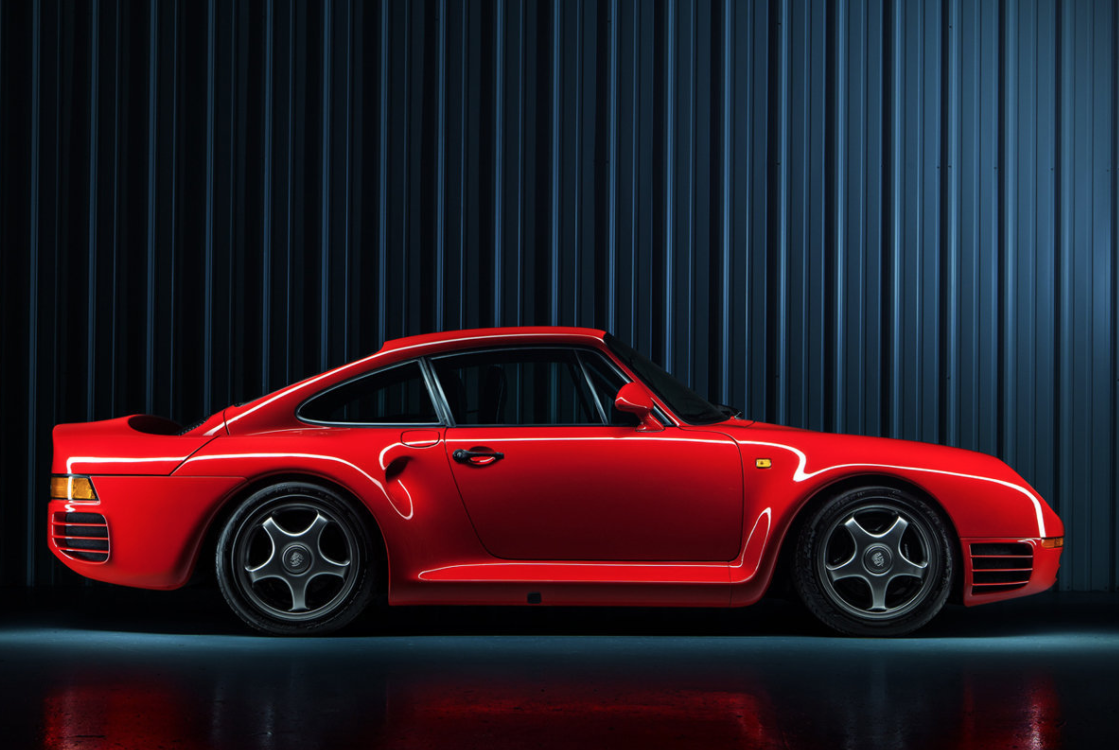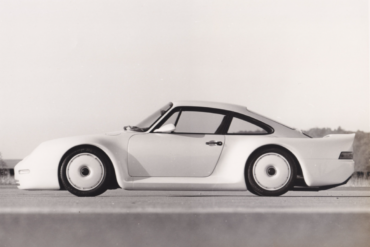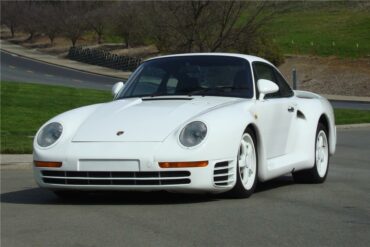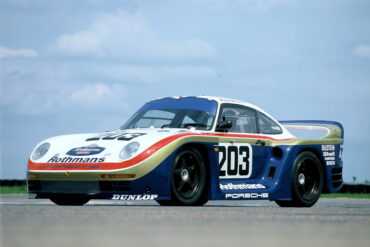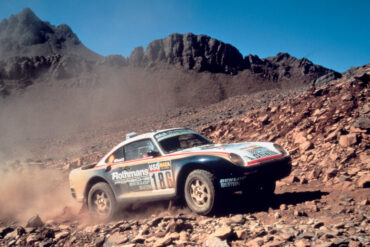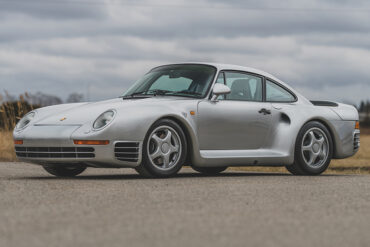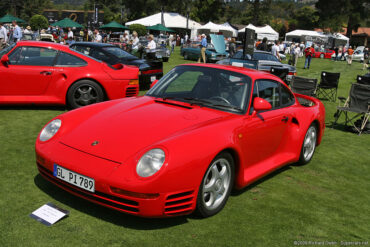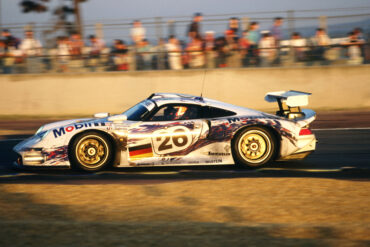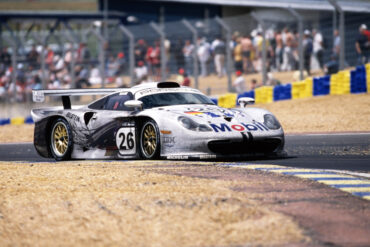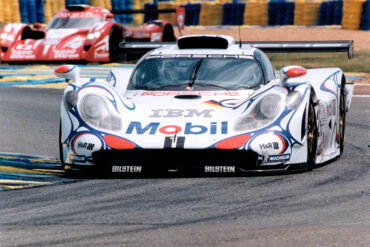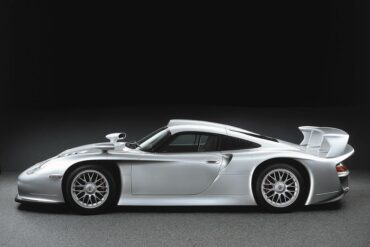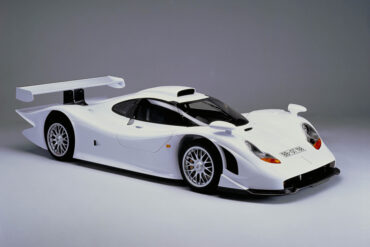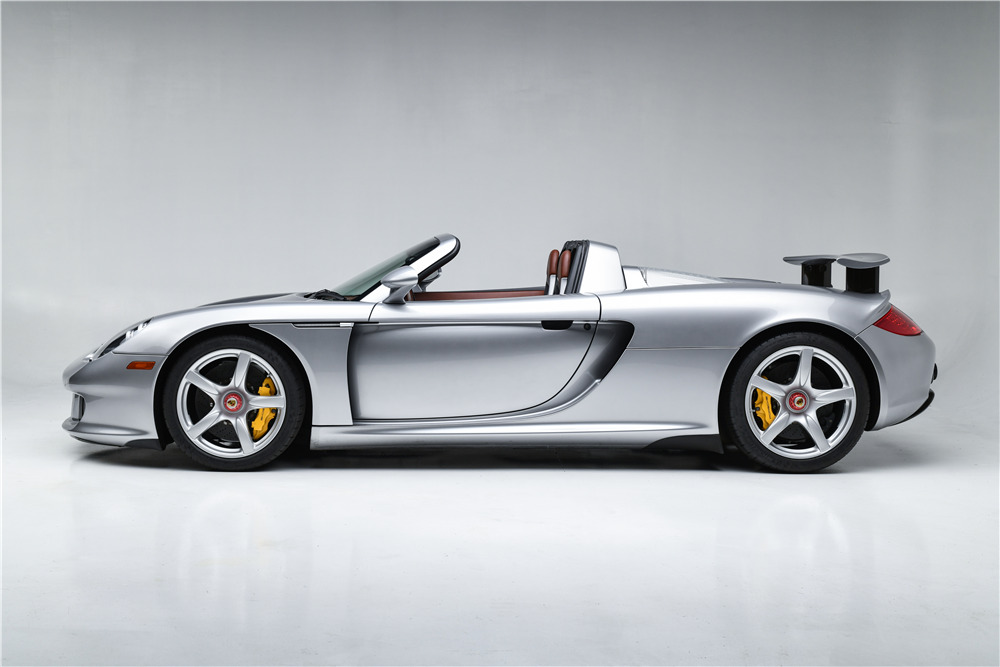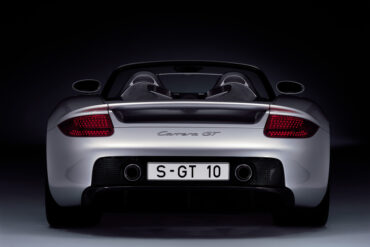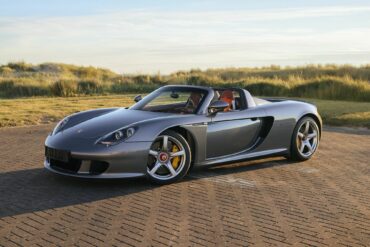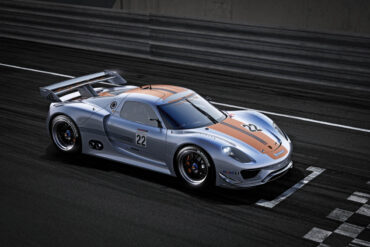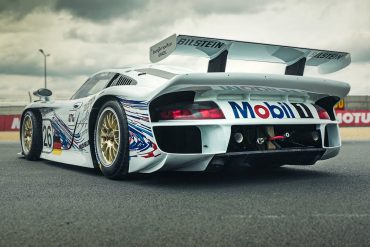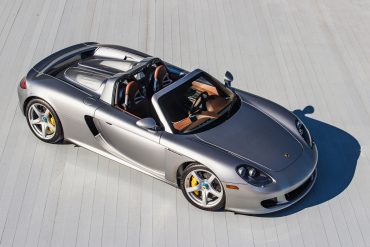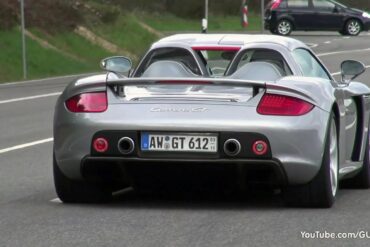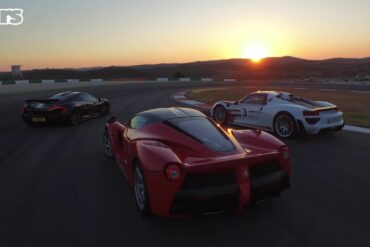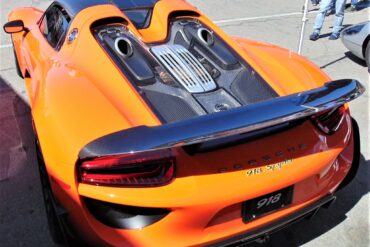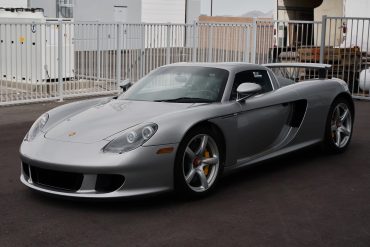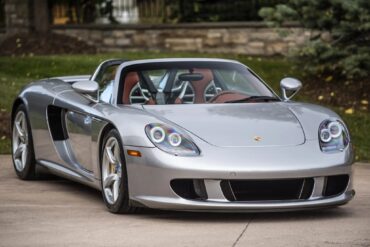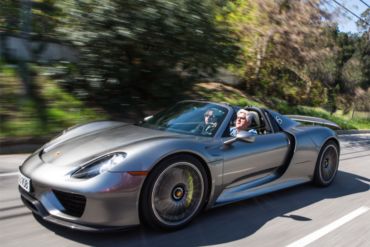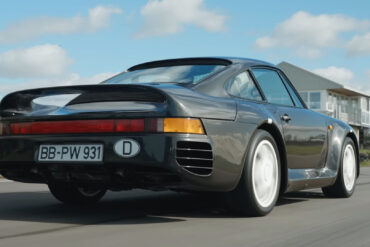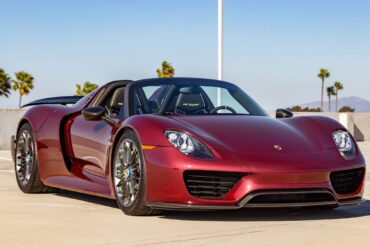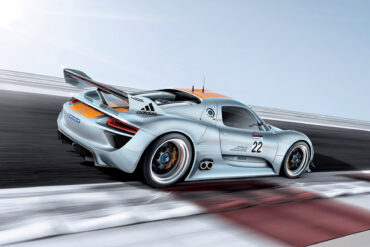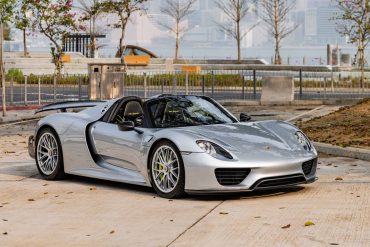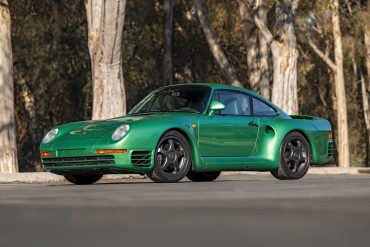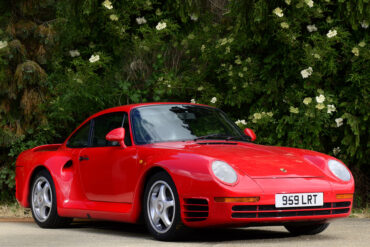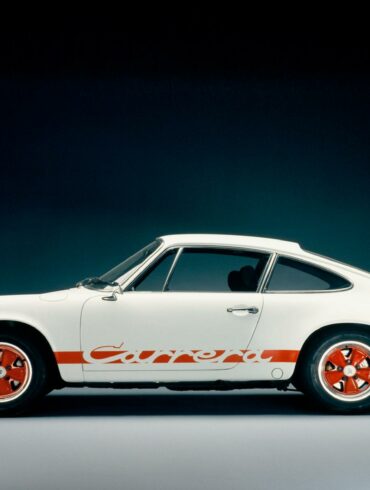Porsche Supercars & Hypercars
Pinnacle Porsche Machines
Porsche 959 / Porsche 911 GT1 / Porsche Carrera GT / Porsche 918 Spyder
Sure, the 911 Turbo and 911 GT2 RS are impressive "super cars" in today's world, but they aren't true "supercars". This page is dedicated to those pinnacle cars, the top of the Porsche heap, the rarified hypercars that Porsche created over the years that stand alone. Porsche has developed many amazing cars over the years, but in our world we only consider four models to be worthy of inclusion. The cars are the Porsche 959, the Porsche 911 GT1, the Porsche Carrera GT and the Porsche 918 Spyder.
The most recent model on the list is the Porsche 918 Spyder, the only "hypercar" here. The 918 Spyder was the ultimate Porsche. It bought Porsche into the world of electrification with a unique plug-in hybrid drivetrain that produced a whopping 887 hp. Performance was absolutely astonishing, with 0 - 60 mph in in just 2.2 seconds and a Nürburgring Nordschleife time of 6 minutes and 57 seconds. Released in a limited edition of just 918 units, it was an absolutely amazing car. While the spec sheet suggested the McLaren P1 was faster at the time, in the real world, the Porsche's superb traction ensures things are a little closer. Throttle response and the engine's exploitability help the Porsche stand out, and as always most pundits picked it as their favorite hypercar of the era.
Before the Porsche 918 was the Porsche Carrera GT. Derived for production from a canceled racecar program, the Carrera GT arrived in 2004, packing a unique 5.7-liter V10 smack in the middle of its carbon monocoque chassis, driving 612 horsepower to the rear wheels through a six-speed manual transmission. It was notoriously difficult to control, but talented hands could hustle it to 60 in 3.6 seconds and on to a 205 mph top speed. With an original MSRP close to $450,000 this limited production run Porsche (1270 units) is now considered one of the best supercars ever made (alongside names like the Ferrari F40.
One of the rarest and most extreme Porsche supercars was even more of a racecar for the road than the Carrera GT. The 911 GT1 may have been no more related to the roadgoing 911 sportscar than by name, but it went on to win 47 endurance races, including the 1998 24 Hours of Le Mans. Homologation regulations mandated Porsche build a limited run of 25 road-going "Strassenversion" models, with its mid-mounted 3.2-liter twin-turbo flat six slightly detuned to 537 horsepower. With just over 2,500 lbs to motivate and an extreme racing chassis, it reached 62 in 3.9 seconds and a 191 mph top speed.
Originally built as a Group B rally car, the 959 was Porsche's original supercar. Porsche eventually built in a limited run of 337 units. When it hit the road, the 959 was the fastest and most technologically advanced car ever made. It packed an advanced all-wheel drive system and a twin-turbo flat six with 444 horsepower to drive it to 62 mph in 3.7 seconds and on to a 195mph top speed. It was so technically advanced for the time that it blew every competitor out of the water.
The Porsche 959
There were two main Porsche 959 models. The 959 Komfort is the core model that was sold, while the Porsche 959 S or "959 Sport" came with larger turbochargers that increased power output to 508 hp and higher top speed, as well as 100kg in less weight. Much rarer, the 959 Sport had a limited run of only 29 cars. Important to note is that official Porsche 959 production ended after the 1988 model year, but in 1992/1993, Porsche built eight more cars assembled from spare parts from the inventory at the manufacturing site in Zuffenhausen. All eight were "Komfort" versions: four in red and four in silver. These cars featured a newly developed speed-sensitive damper system and were much more expensive than the earlier units. The Porsche 959 has a rich history. From prototypes, to race-build rally cars and purpose build 961 race car, there are several models worth mentioning. They all play an important part in the Porsche 959 story.
Certain cars in history force the competition to pull their socks up and embrace the future. The Porsche 959 not only remains one of the most interesting supercars ever built, but it also fits the definition of cars that moved the game so far forward that everybody stood up and took notice.
Featuring a 2.85-litre turbocharged rear-mounted flat-six engine based on the flat-six out of a 911, which put 450hp at 6500rpm to all four wheels, the 959 was the peak of supercar performance in its day. Features like anti-lock brakes were a fairly recent innovation at the time, but the 959’s technological innovation didn’t stop there. Eight hydraulic dampers - four at each corner - meant the 959 did without anti-roll bars. Electronic ride height and damping adjustments were made by the car’s on-board computer, allowing the car to automatically lift or lower itself depending on the conditions and speed.
The 959 was the first production car to be fitted with an electronic tyre pressure monitoring system, which worked on some of the world’s first run-flat tires - Bridgestone RE71 Denlocs. Those tires were fitted onto the world’s first production-car magnesium wheels, with hollow spokes. The 959 also featured a front diff with hydraulically-actuated clutches that were computer-controlled. At a time when mobile phones were the size of your face and barely had screens, the technology seen on the Porsche 959 seemed out of this world, with performance figures that remain competitive with the current crop of supercars.
Incredibly for a car that was designed over 30 years ago, the Porsche 959’s performance stacks up with many supercars and sports cars today. 0-60 takes just 3.9 seconds in the 959, with car topping out at 196mph. The 959’s power comes courtesy of a 2.85-litre flat-six power plant, mounted in the rear, which is both air-cooled and water-cooled, as well as turbocharged for good measure. This endows it with 450hp at 6500rpm - with a 1450kg kerb weight and extra-slippery aero body helping make that engine’s life easier. Most impressive of all is the all-wheel-drive system that transmits that power to the road. All-wheel-drive is a fairly common feature of many modern supercars, but back in the eighties a system like the Porsche-Stuer Kupplung (PSK) all-wheel-drive system had never been seen.
When new, the Porsche 959 cost $225,000, which at the time made it one of the most expensive cars on the market. The Porsche 959 received almost unanimous praise, with hyperbole the norm in reviews from the time of its launch. As you’ll see, there is very little criticism able to be leveled at the car, with most reviewers simply in awe of its technological achievement, and the performance ramifications of this. The phrase ‘game changer’ is bandied around quite loosely these days, but seldom have they been more appropriate as when applied to the Porsche 959. It launched the supercar into the 21st century, despite arriving a decade and a half before the millennium, forcing other manufacturers and established names to up their game. Extraordinary performance was made available without the need to compromise on comfort or on-road stability.
The Porsche 959
All the research, specs, history and much more
The Porsche 911 GT1
Worldwide sports car racing was hugely popular in 1990s. Porsche wanted in on the action so they jumped into the BPR Global GT1 Championship (which would become FIA World GT Championship later on in 1997). The 962 racers weren’t fit for the job anymore, already being beaten by the McLaren F1 GTRs in 1995. Therefore, a new car was needed. And it came six weeks later as the Porsche 911 GT1. The 911 GT1 was mid-engined - a step in a different direction from the rear-engined 911s - but another aspect stood out: instead of being derived from a street-legal vehicle, it was brewed from the off as a full-blown race car. Once again, Porsche found a way.
The post-962 era for Porsche racing was a somewhat weird and tumultuous time. Sanctioning bodies and rules were in flux in both prototype and GT racing. Porsche’s response was to move away from prototypes back toward production-based racing models. Into the GT-sanctioning breach came a group that included Porsche’s own Jürgen Barth, the “B” in the BPR Global GT Series, together with Patrick Peter and Stephane Ratel.
The initial rules package was considered loose, and McLaren was the first to take advantage of the situation. Their BMW-powered F1 GTR was unbeatable, and it won the 1995 running of Le Mans. That sent Porsche’s famed Norbert Singer and his experienced engineering squad to the drawing boards. Singer had concise orders: build as fast as possible a car that retains the 911’s soul. While most manufacturers built a road car and then invested to turn it into the track-only cars, Porsche went straight for the race prototype first and production car second. Singer basically took the front end of the 911 993 and mounted it to the rear end of the 962. The whole build was held together by a tubular frame that allowed both mid- and rear-engine positioning. The engine was a 3.2-liter, water-cooled flat-six making around 600 hp, thanks to two KKK turbochargers nicely jammed under the carbon fiber body. Weight came in at 1,050 kilos, which allowed Porsche to fit the 911 GT1 with a larger air intake and bump the horsepower.
The 911 GT1 made its debut in 1996 at the Le Mans 24 Hour Race. It placed 2nd and 3rd at Le Mans in 1996 — and won the GT1 class, just one lap down to the winning prototype TWR/Porsche. The GT1 also went on to win the last three BPR Global GT races of the season.
The FIA returned to sanctioning GT racing for 1997. Peter and Ratel parted ways with BPR, creating separate smaller national series. Unfortunately, the FIA looked at the Porsche GT1’s performance at Le Mans and those last three BBR races in 1996 and put induction restrictors on the car. FIA also had firmer homologation rules than BPR. No longer would a manufacturer’s promise to build 20 road cars “sooner or later” suffice. At the same time, a new rival was shaping on the horizon: the Mercedes-Benz CLK GTR. In response, Porsche came up with an improved version of the 911 GT1, which added the Evolution suffix.
Visual changes included 911 996-style headlights while other tweaks resumed to better aerodynamics and retuned suspension. 1997 didn’t bring the victory for the 911 GT1. Mercedes/AMG and McLaren/BMW dominated GT racing in 1997, although that same Joest-owned TRW-Porsche again won Le Mans as a prototype. At the Sarthe, the updated 1997 Porsche GT1 Evolution finished 3rd and 4th in GT1 (5th and 8th overall) behind McLaren F1s in 1st and 2nd (3rd and 4th overall). What 1997 brought, however, was the 911 GT1 Straßenversion (or Strassenversion, literally ‘street version’ in German).
Porsche kept the project’s heart pumping and made massive changes for 1999. Singer and his staff redesigned the GT1. They changed from steel to carbon fiber for the monocoque tub (the body panels were always carbon fiber), reworked the dimensions so they could move the gas tank from the front trunk to the rear bulkhead just ahead of the engine, and they tweaked the suspension and the aerodynamics. Although the Mercedes CLK/GTRs won literally every race in the 1998 FIA GT1 Series, Porsche’s 1st and 2nd overall finishes at Le Mans. The 1998 Strassenversion was a toned down version of the race-ready GT1 as Porsche upped the ground clearance, softened the suspension, slightly detuned engine and gave the car a more friendly interior. Even so, the street version of the GT1 911 was still capable of doing 193 mph and reach 60 mph from a standstill in just 3.7 seconds.
The Porsche 911 GT1
All the research, specs, history and much more
The Porsche Carrera GT
For the 2000 Paris Motor Show, Porsche prepared a concept supercar that eventually turned into a limited production car. The concept's basic shape and specification were close the production version, which included a low-mounted V10 engine that was sourced from their scrapped Le Mans prototype program in 1999. The production Carrera GT launched in 2003 and production ran through 2007, with 1,270 units produced.
Released at the 2003 Geneva Auto Show, Porsche's Carrera GT was a final production version of the concept car first seen at the 2001 Paris Auto Salon. It was Porsche's first limited production supercar since 959 production stopped in 1988. At the time of launch, it was one of the few available products that rivaled the Ferrari Enzo. Unlike the 911, which carried the company for four decades, the Carrera GT was complete bottom up design. Its styling was thankfully unchanged from Paris show car and departed from the traditional Porsche shape which the 959 couldn't escape.Motivation for the Carrera GT came directly from Porsche's successful motor sports program and the Porsche WSC-95 Le Mans prototype. After winning Le Mans twice in 1996 and 1997, Porsche revived an old V10 engine for the 1999 season but it was shelved only two days into track testing.
Fortunately, the 5.5 liter V10 was used in a one-of 2001 Paris Auto Salon concept car which was received well enough for production to begin two years later. Final Assembly commenced at Porsche's Leipzig plant and the car sold with an MSRP of $440,000 USD, $515,000 CAD, or €390,000.Under the skin, the car used many modern hallmarks of motor sport engineering: a carbon fiber chassis, dry sump lubrication, inboard suspension and a mid-mounted engine that was engineered to sit as low as possible to ground. Careful attention was also paid to under tray airflow which could be managed better than the rear-engine 911.
Porsche's V10 engine can trace its roots back to a unit developed in secret by Porsche for the Footwork Formula One team. This development halted in 1992, but was resurrected for a WSC-95 successor that was never completed. Bored out to 5.5 liters, this unit then found its way into the Carrera GT Prototype. When production commenced, it was modified by Porsche engineers to ensure more power and reliability. Such revisions included a larger displacement which offered more torque and driveability. This engine is placed in the middle of the chassis in a three-point carbon subframe. This is unlike Paris Show Car which featured its V10 as a load bearing structure within the chassis. Had Porsche not used a subframe, noise leakage and vibration would have hampered interior comfort.
Comparison between the Carrera GT and Ferrari Enzo is inevitable. Both entered the market at the top of the product range and both place heavy emphasis on driver-oriented driving, but each executes this philosophy in a different way. Where the Enzo has three driving modes, and a huge bevy of electronic systems, the Carrera is stripped down to basic performance. This is largely due to the fact that the Carrera only has a 6-Speed Manual whereas the Enzo is equipped with a paddle-shift, computer controlled, 6-speed sequential. Getting back to basics is somewhat cheaper, since the Carrera GT was $444,400 when new compared to the $660 000 USD Enzo. With regards to pure performance, the Enzo does have 48 more horsepower (35.8 kW), and weighs 33 lbs (15 kgs) less which would make it win on any straight.
The Carrera GT on the other hand, offers much more down force and might possibly catch up in the turns. In any case, if either car is superior, the margin is so narrow that it's more a question of driver skill.
The Porsche Carrera GT
All the research, specs, history and much more
The Porsche 918 Spyder
With the engineering might (and budget) of Porsche behind it, and drawing upon the company’s experience of racing hybrids in endurance racing, the 918 Spyder managed to undercut its rivals on price, while providing arguably the most complete road car package of the holy trinity. Appropriately, 918 examples of the Spyder were promised, with Porsche digging deep into its motorsport knowledge to produce technology that provided world-beating performance.
The Porsche 918 Spyder was a mid-engined, plug-in hybrid hypercar that finally proved that gearheads had nothing to worry about when it came to hybrid technology becoming a bigger part of our automobiles. The heart of the Porsche 918 Spyder was a naturally-aspirated 4.6-liter V8 engine that was capable of producing 608 horsepower that was paired with two electric motors that delivered an additional 279 horsepower each, for a combined total of 887 horsepower. Production on the Porsche 918 began on September 18, 2013 and ran through June 2015 (all VINs were 2015 model year cars).
Each car had a starting price of $845,000 (U.S.) and sold out quickly (by December, 2014). The car was an absolute beast. In an independent series of speed tests performed by Car and Driver Magazine, the Porsche 918, achieved a 0-62 mph of just 2.6 seconds, a 0-100 mph time of 4.9 seconds and a 0-180 mph time of just 17.5 seconds. It is one of the fastest accelerating cars on the planet and its top speed is up there too with the fastest cars in the world. More importantly, it was an amazing car to drive, Porsche having nailed the calibration of the advanced systems, allowing the car to be pushed to its limits while still feeling like a true Porsche sports car.
The Porsche 918 Spyder
All the research, specs, history and much more
Join Our Porsche Community
Sign up for our weekly Porsche newsletter. The latest Porsche news, rumors, reviews and more delivered to your inbox. Cool Porsche stuff perfect for the flat-six obsessed.


